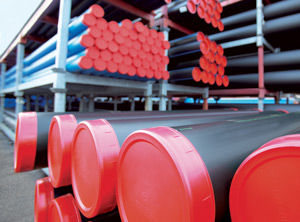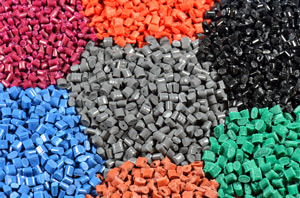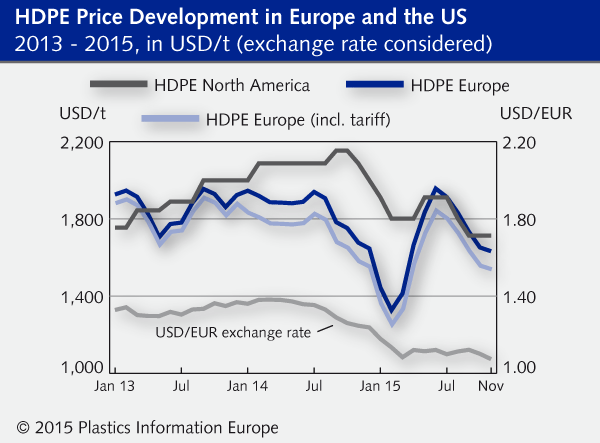ANNUAL REVIEW 2015
Polyolefins: A year of sweeping changes in Europe / Global PE market consolidates / Prices decouple from base feedstock costs / Comprehensive restructuring / Plastics processing faces new challenges
The year 2015 will no doubt be remembered in the European plastics industry as a special turning point. Structural shifts in the mechanisms of the global polyolefin landscape began to have a massive impact on the European market. In spring, the industry was confronted with previously unheard-of bottlenecks in the supply of polymer materials, and despite the steep fall in oil prices, plastics notations virtually exploded. Many watched in sheer disbelief as the proven measures of scale – the feedstock prices – started to lose their indicative value. Even in late summer and autumn, a lot of insiders still believed the situation would once again normalise. But if there is one thing that developments in November and the ongoing month of December prove irrefutably, it is that little will remain as it once was following 2015.
The first sign that something was amiss came in January, even though in hindsight the incident turned out to be just a harmless harbinger of what was still to come. The installation of a new logistics software temporarily took out some of the deliveries of a leading global producer’s European subsidiary. However, after the problems had been fixed within a week, the uproar subsided. At the same time, PE and PP prices fell by triple digits, following the downward spiral in global oil notations. Everything seemed as it should be, and many processors held back on their orders in the hopes of further price declines. Availability appeared guaranteed, not least since the macroeconomic setting was rather normal.
The first sign that something was amiss came in January, even though in hindsight the incident turned out to be just a harmless harbinger of what was still to come. The installation of a new logistics software temporarily took out some of the deliveries of a leading global producer’s European subsidiary. However, after the problems had been fixed within a week, the uproar subsided. At the same time, PE and PP prices fell by triple digits, following the downward spiral in global oil notations. Everything seemed as it should be, and many processors held back on their orders in the hopes of further price declines. Availability appeared guaranteed, not least since the macroeconomic setting was rather normal.
February marked the turnaround
But the situation quickly changed in the ensuing month. By 6 February, numerous suppliers had announced order stops, delivering no volumes beyond those ordered by their regular customers. Since this was by no means the first time in history that an order stop had been called, the excitement remained contained. In the final monthly tally, many standard thermoplastics prices fell again. However, several spot markets started showing significant gaps in availability, and on this front, notations rose drastically throughout February.
 Pipe producers had to switch off their lines following a lack of material (Photo: Simona) |
Yet even then, it was impossible to predict the events of the following months. In March, polymer notations made an unusually drastic turnaround, despite the fact that feedstock costs and the global oil chains remained at a low level. Many processors saw their contracts lifted by triple digits, a development that was accompanied by an unprecedented spate of forces majeures for European PE and PP plants in particular. It almost seemed as though the weight of producers' crippled margins proved too much to bear for the region’s ailing and failing plants.
The calls for FM freed producers of many conditions set out in their supply agreements. In some market segments, including pipe production, extrusion lines actually stood still for lack of input material. This situation of extreme tightness continued into June, and was accompanied by a virtual explosion in polymer prices. PE market developments in particular started to impact the entire European standard thermoplastics market, setting of a wildfire.
The calls for FM freed producers of many conditions set out in their supply agreements. In some market segments, including pipe production, extrusion lines actually stood still for lack of input material. This situation of extreme tightness continued into June, and was accompanied by a virtual explosion in polymer prices. PE market developments in particular started to impact the entire European standard thermoplastics market, setting of a wildfire.
No returning to the way things were
It took until the summer for the situation to ease somewhat, and for availability to gradually improve, bringing polymer prices more or less back in line with feedstock notations. Propylene prices fell particularly quickly, pulling PP down with them. Despite the downtrend, producers’ margins remained at previously unknown heights, leading many buyers to assume that a lot of concessions could still be squeezed out of them – after all, suppliers continued to make big bucks.
 Availability of plastic resin was tight, even without the flood of FMs (Photo: digitalstock/Fotolia) |
That belief was disproved for good in November. It became increasingly clear that producers had meanwhile assumed a firm grip on supply, and the mere sign of a potential blow to their margins was met with resolute action on their part. After some surplus volumes were sold off in early October, suppliers once again lifted notations. A month later, several production plants suffered problems again, causing supply bottlenecks. That development went hand in hand with renewed price hikes – even if the feedstock front did not provide much rationale for an uptrend.
There was, however, no repeat of the sheer flood of FMs announced in spring. Many players reported that the once customary and contractually agreed link between polymer prices and feedstock costs has been done away with by most suppliers. Even though global oil notations remain weak, there are already signs that polymer prices will rise again in December. For producers, this means they can check off 2015 as a very successful year – after all, their customers have remained in business, even if their existence did at times come under threat.
There was, however, no repeat of the sheer flood of FMs announced in spring. Many players reported that the once customary and contractually agreed link between polymer prices and feedstock costs has been done away with by most suppliers. Even though global oil notations remain weak, there are already signs that polymer prices will rise again in December. For producers, this means they can check off 2015 as a very successful year – after all, their customers have remained in business, even if their existence did at times come under threat.
The birthing pains of a new global market reality
In the early days of summer it became increasingly apparent that market developments did not follow their customary paths. Powerful forces appeared to be at work, bringing about wide-ranging changes – the type referred to in hindsight as “historical”. As customary during such times, a number of causes converged, and their collective impact has had a dramatic effect.
The underlying trend has been pointing in this direction for some years already, and numerous experts have given their two cents on it. There is no denying that over the past 20 years the Arab world has single-mindedly built up competitively-priced polymer production facilities, whose output is mostly earmarked for export. From 2008 to 2012 alone, the member states of the Gulf Cooperation Council (GCC) doubled their PE capacities to almost 15m t/y. The key end markets for their polymers are in Asia, Europe and North America. This development has resulted in the Middle East’s becoming the Mecca of the polyethylene world, determining the course of the global PE market.
While these capabilities were being built up, European refineries continued to be shut down. From 2006 to 2014, the continent’s capacities for crude oil processing contracted by about 10% as a result of the authorities’ drive to lower the consumption of fossil fuels to safeguard the environment. One of the collateral effects of this trend that has received little mention so far is that the decline in oil processing has also resulted in a 10% drop in European capacities for naphtha – the by-product of refineries and the main feedstock for western European thermoplastics production. In the last few years, the region’s ethylene capacity and output has fallen by about 10%, too – resulting in the closures of a number of PE plants. In the period from 2011 to early 2015 alone, some 1.5m t/y in polyethylene capacities were decommissioned in Europe.
The underlying trend has been pointing in this direction for some years already, and numerous experts have given their two cents on it. There is no denying that over the past 20 years the Arab world has single-mindedly built up competitively-priced polymer production facilities, whose output is mostly earmarked for export. From 2008 to 2012 alone, the member states of the Gulf Cooperation Council (GCC) doubled their PE capacities to almost 15m t/y. The key end markets for their polymers are in Asia, Europe and North America. This development has resulted in the Middle East’s becoming the Mecca of the polyethylene world, determining the course of the global PE market.
While these capabilities were being built up, European refineries continued to be shut down. From 2006 to 2014, the continent’s capacities for crude oil processing contracted by about 10% as a result of the authorities’ drive to lower the consumption of fossil fuels to safeguard the environment. One of the collateral effects of this trend that has received little mention so far is that the decline in oil processing has also resulted in a 10% drop in European capacities for naphtha – the by-product of refineries and the main feedstock for western European thermoplastics production. In the last few years, the region’s ethylene capacity and output has fallen by about 10%, too – resulting in the closures of a number of PE plants. In the period from 2011 to early 2015 alone, some 1.5m t/y in polyethylene capacities were decommissioned in Europe.
The shale gas revolution has yet to arrive
Of course, European PE production stands no chance against the much cheaper Arab product. Increasing volumes of the standard plastic – consisting mostly of LLD and HD grades – are making their way from the Middle East to Europe. In an effort aimed at protecting what little plants remain on the continent, the EU in January 2014 lifted the import duties for polyolefins from 3% to 6.5%, making imports to the region that much more expensive.
The creeping decline in the euro’s value against the US dollar, which began in August 2014, proved to be the straw that broke the camel’s back, ringing in the PE crisis that hit this spring. Prior to that, European standard thermoplastics prices had traditionally been tied to feedstock cost developments. It was this link that drove plastics prices in the Eurozone down up until February 2015. However, in a comparison with US dollar-based prices – which dominate the international oil and petrochemical markets – it became evident in February that, as a result of the currency effect, European and North American PE notations showed price differences of more than USD 500/t. In other words, USD 500/t that the potential supplier to Europe would have to forego – and, not surprisingly, therefore refused to deliver at such terms.
The creeping decline in the euro’s value against the US dollar, which began in August 2014, proved to be the straw that broke the camel’s back, ringing in the PE crisis that hit this spring. Prior to that, European standard thermoplastics prices had traditionally been tied to feedstock cost developments. It was this link that drove plastics prices in the Eurozone down up until February 2015. However, in a comparison with US dollar-based prices – which dominate the international oil and petrochemical markets – it became evident in February that, as a result of the currency effect, European and North American PE notations showed price differences of more than USD 500/t. In other words, USD 500/t that the potential supplier to Europe would have to forego – and, not surprisingly, therefore refused to deliver at such terms.
 | |
At the same time, Europe’s highly consolidated production landscape is no longer capable of meeting regional processors’ demands. In such a scenario, buyers have little alternative but to procure their polymer volumes at the going global rate. In fact, they have to pay more than their competitors elsewhere in the world as a result of the higher import duties – whose raison d'être is increasingly being questioned. Nowadays, polymer prices in different world regions are much more interconnected – a development that became painfully tangible in Europe for the first time in 2015.
As the year draws to a close, many customary trade practices have vanished into thin air, leaving the markets wrought with insecurity. Europe remains in a state of limbo, not least since the US shale gas revolution, which has already rattled the global oil markets, has yet to have a noticeable impact on polyolefin production. If there is one thing that is certain in these uncertain times it is that there is no way of returning to the way things were.
11.12.2015 Plasteurope.com [232781-0]
Published on 11.12.2015
